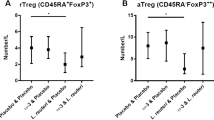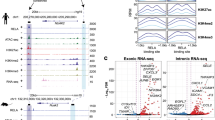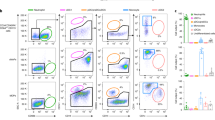Abstract
Dietary n-3 polyunsaturated fatty acids (PUFA) may represent a mode of allergy prevention. Cord blood (CB) CD34+ hemopoietic progenitors are altered in infants at risk of atopy. We therefore studied the effects of dietary n-3 PUFA supplementation during pregnancy on numbers and function of progenitors in neonates at high risk of atopy. In a double-blind study, atopic, pregnant women were randomized to receive fish oil capsules or placebo from 20 wk gestation until delivery. At birth, CB CD34+ cells were isolated and analyzed by flow cytometry for expression of cytokine (IL-5Rα, IL-3Rα, granulocyte/macrophage colony-stimulating factor Rα) or chemokine (CXCR4 and CCR3) receptors. CB cells were also cultured in methylcellulose assays for eosinophil/basophil colony-forming cells. At age 1 y, infants were clinically assessed for atopic symptoms and skin tests. Percentages of CB CD34+ cell numbers were higher after n-3 PUFA than placebo. Co-expression of cytokine or chemokine receptors on CD34 cells was not altered by n-3 PUFA supplementation. However, there were significantly more IL-5-responsive CB eosinophil/basophil colony forming units (Eo/B-CFU) in the fish oil, compared with the control, group. Overall, there was a positive association between CD34+ cells and IL-5-responsive Eo/B-CFU in CB and 1 y clinical outcomes, including atopic dermatitis and wheeze. Dietary n-3 PUFA supplementation during pregnancy in atopic mothers alters infant cord blood hemopoietic progenitor phenotype. This may have an impact on development of atopic disease.
Similar content being viewed by others
Log in or create a free account to read this content
Gain free access to this article, as well as selected content from this journal and more on nature.com
or
Abbreviations
- AEDS:
-
atopic eczema/dermatitis syndrome
- CB:
-
umbilical cord blood
- DHA:
-
docosahexaenoic acid
- Eo/B-CFU:
-
eosinophil/basophil colony forming units
- EPA:
-
eicosapentaenoic acid
- GM-CSF:
-
granulocyte/macrophage colony-stimulating factor
- MNC:
-
mononuclear cell
- NAMNC:
-
nonadherent mononuclear cell
- n-3 PUFA:
-
omega-3 polyunsaturated fatty acids
- PE:
-
phycoerythrin
- SPT:
-
skin prick test
References
Strachan DP 1989 Hay fever, hygiene, and household size. BMJ 299: 259–1260
Holt PG, Macaubas C, Stumbles PA, Sly PD 1999 The role of allergy in the development of asthma. Nature 402: 12–B17
Prescott SL, Macaubas C, Holt BJ, Smallacombe TB, Loh R, Sly PD, Holt PG 1998 Transplacental priming of the human immune system to environmental allergens: universal skewing of initial T cell responses toward the Th2 cytokine profile. J Immunol 160: 730–4737
Purasiri P, Mckechnie A, Heys SD, Eremin O 1997 Modulation in vitro of human natural cytotoxicity, lymphocyte proliferative response to mitogens and cytokine production by essential fatty acids. Immunology 92: 66–172
Calder PC, Miles EA 2000 Fatty acids and atopic disease. Pediatr Allergy Immunol 11( suppl 13): 9–36
Soyland E, Nenseter MS, Braathen L, Drevon CA 1993 Very long chain n-3 and n-6 polyunsaturated fatty acids inhibit proliferation of human T-lymphocytes in vitro. Eur J Clin Invest 23: 12–121
Denburg JA 1991 Basophils, mast cells and eosinophils and their precursors in allergic rhinitis. Clin Exp Allergy 21: 53–258
Sehmi R, Howie K, Sutherland DR, Schragge W, O'Byrne PM, Denburg JA 1996 Increased levels of CD34+ hemopoietic progenitor cells in atopic subjects. Am J Respir Cell Mol Biol 15: 45–655
Upham JW, Hayes LM, Lundahl J, Sehmi R, Denburg JA 1999 Reduced expression of hemopoietic cytokine receptors on cord blood progenitor cells in neonates at risk for atopy. J Allergy Clin Immunol 104: 70–375
Dunstan JA, Mori TA, Barden A, Beilin LJ, Taylor AL, Holt PG, Prescott SL 2003 Maternal fish oil supplementation in pregnancy reduces interleukin-13 levels in cord blood of infants at high risk of atopy. Clin Exp Allergy 33: 42–448
Mori TA, Beilin LJ, Burke V, Morris J, Ritchie J 1997 Interactions between dietary fat, fish, and fish oils and their effects on platelet function in men at risk of cardiovascular disease. Arterioscler Thromb Vasc Biol 17: 79–286
Ruiz RG, Kemeny DM, Price JF 1992 Higher risk of infantile atopic dermatitis from maternal atopy than from paternal atopy. Clin Exp Allergy 22: 62–766
Martinez FD 1997 Maternal risk factors in asthma. Ciba Found Symp 206: 33–239
Upham JW, Holt BJ, Baron-Hay MJ, Yabuhara A, Hales BJ, Thomas WR, Loh RK, O'Keeffe PT, Palmer L, Le Souef PN, Sly PD, Burton PR, Robinson BWS, Holt PG 1995 Inhalant allergen-specific T-cell reactivity is detectable in close to 100% of atopic and normal individuals: covert responses are unmasked by serum-free medium. Clin Exp Allergy 25: 34–642
Macaubas C, Sly PD, Burton P, Tiller K, Yabuhara A, Holt BJ, Smallacombe TB, Kendall G, Jenmalm MC, Holt PG 1999 Regulation of T-helper cell responses to inhalant allergen during early childhood. Clin Exp Allergy 29: 223–1231
Ausiello CM, Lande R, Urbani F, la Sala A, Stefanelli P, Salmaso S, Mastrantonio P, Cassone A 1999 Cell-mediated immune responses in four-year-old children after primary immunization with acellular pertussis vaccines. Infect Immun 67: 064–4071
Denburg JA, Telizyn S, Messner H, Lim B, Jamal N, Ackerman SJ, Gleich GJ, Bienenstock J 1985 Heterogeneity of human peripheral blood eosinophil-type colonies: evidence for a common basophil-eosinophil progenitor. Blood 66: 12–318
Sehmi R, Wood LJ, Watson R, Foley R, Hamid Q, O'Byrne PM, Denburg JA 1997 Allergen-induced increases in IL-5 receptor α-subunit expression on bone marrow-derived CD34+ cells from asthmatic subjects. A novel marker of progenitor cell commitment toward eosinophilic differentiation. J Clin Invest 100: 466–2475
Sutherland DR, Keating A, Nayar R, Anania S, Stewart AK 1994 Sensitive detection and enumeration of CD34+ cells in peripheral and cord blood by flow cytometry. Exp Hematol 10: 003–1010
Dunstan JA, Mori TA, Barden A, Beilin LJ, Taylor AL, Holt PG, Prescott SL 2004 Fish oil supplementation in pregnancy modifies neonatal allergen-specific immune responses and clinical outcomes in infants at high risk of atopy: a randomised, controlled trial. J Allergy Clin Immunol 112: 178–1184
Denburg JA, Richardson M, Telizyn S, Bienenstock J 1983 Basophil/mast cell precursors in human peripheral blood. Blood 61: 75–780
Calder PC, Yaqoob P, Thies F, Wallace FA, Miles EA 2002 Fatty acids and lymphocyte functions. Br J Nutr 87: 31–S48
Hughes DA, Pinder AC 1997 N-3 polyunsaturated fatty acids modulate the expression of functionally associated molecules on human monocytes and inhibit antigen-presentation in vitro. Clin Exp Immunol 110: 16–523
Fritsche KL, Byrge M, Feng C 1999 Dietary omega-3 polyunsaturated fatty acids from fish oil reduce interleukin-12 and interferon-gamma production in mice. Immunol Lett 65: 67–173
Endres S, Meydani SN, Ghorbani R, Schindler R, Dinarello CA 1993 Dietary supplementation with n-3 fatty acids suppresses interleukin-2 production and mononuclear cell proliferation. J Leukoc Biol 54: 99–603
Meydani M, Natiello F, Goldin B, Free N, Woods M, Schaefer E, Blumberg JB, Gorbach SL 1991 Effect of long-term fish oil supplementation on vitamin E status and lipid peroxidation in women. J Nutr 121: 84–491
Virella G, Fourspring K, Hyman B, Haskill-Stroud R, Long L, Virella I, La Via M, Gross AJ, Lopes-Virella M 1991 Immunosuppressive effects of fish oil in normal human volunteers: correlation with the in vitro effects of eicosapentanoic acid on human lymphocytes. Clin Immunol Immunopathol 61: 61–176
Miles EA, Calder PC 1998 Modulation of immune function by dietary fatty acids. Proc Nutr Soc 57: 77–292
Calder PC 2001 omega 3 polyunsaturated fatty acids, inflammation and immunity. World Rev Nutr Diet 88: 09–116
Duchen K, Bjorksten B 2001 Polyunsaturated n-3 fatty acids and the development of atopic disease. Lipids 36: 033–1042
Braccioni F, Dorman SC, O'Byrne PM, Inman MD, Denburg JA, Parameswaran K, Baatjes AJ, Foley R, Gauvreau GM 2002 The effect of cysteinyl leukotrienes on growth of eosinophil progenitors from peripheral blood and bone marrow of atopic subjects. J Allergy Clin Immunol 110: 6–101
Crawford L, Saito H, Inman MD, Denburg JA 2002 Effects of the cysteinyl leukotriene receptor antagonist, montelukast, on eosinophil differentiation in an experimental mouse model of allergic rhinitis. J Allergy Clin Immunol 109: S296
Prescott SL, Macaubas C, Smallacombe T, Holt BJ, Sly PD, Loh R, Holt PG 1998 Reciprocal age-related patterns of allergen-specific T-cell immunity in normal vs. atopic infants. Clin Exp Allergy 28: 9–44
Prescott SL, Holt PG 1998 Abnormalities in cord blood mononuclear cytokine production as a predictor of later atopic disease in childhood. Clin Exp Allergy 28: 313–1316
Acknowledgements
The authors thank the staff and volunteers who assisted with this study. We also thank the obstetricians and midwives at St. John of God Hospital, Subiaco, Western Australia.
Author information
Authors and Affiliations
Corresponding author
Additional information
Supported by grants from the National Health and Medical Research Council and Raine Medical Research Foundation, Nedlands, Western Australia.
Rights and permissions
About this article
Cite this article
Denburg, J., Hatfield, H., Cyr, M. et al. Fish Oil Supplementation in Pregnancy Modifies Neonatal Progenitors at Birth in Infants at Risk of Atopy. Pediatr Res 57, 276–281 (2005). https://doi.org/10.1203/01.PDR.0000148279.72611.1D
Received:
Accepted:
Issue date:
DOI: https://doi.org/10.1203/01.PDR.0000148279.72611.1D
This article is cited by
-
Atopic dermatitis-like skin lesions are suppressed in fat-1 transgenic mice through the inhibition of inflammasomes
Experimental & Molecular Medicine (2018)
-
Lipoprotein lipase regulates hematopoietic stem progenitor cell maintenance through DHA supply
Nature Communications (2018)
-
Optimization of the viability of stem cells derived from umbilical cord blood after maternal supplementation with DHA during the second or third trimester of pregnancy: study protocol for a randomized controlled trial
Trials (2014)
-
Maternal fish consumption during pregnancy and risks of wheezing and eczema in childhood: The Generation R Study
European Journal of Clinical Nutrition (2013)
-
Atopy Risk in Infants and Children in Relation to Early Exposure to Fish, Oily Fish, or Long-Chain Omega-3 Fatty Acids: A Systematic Review
Clinical Reviews in Allergy & Immunology (2011)



